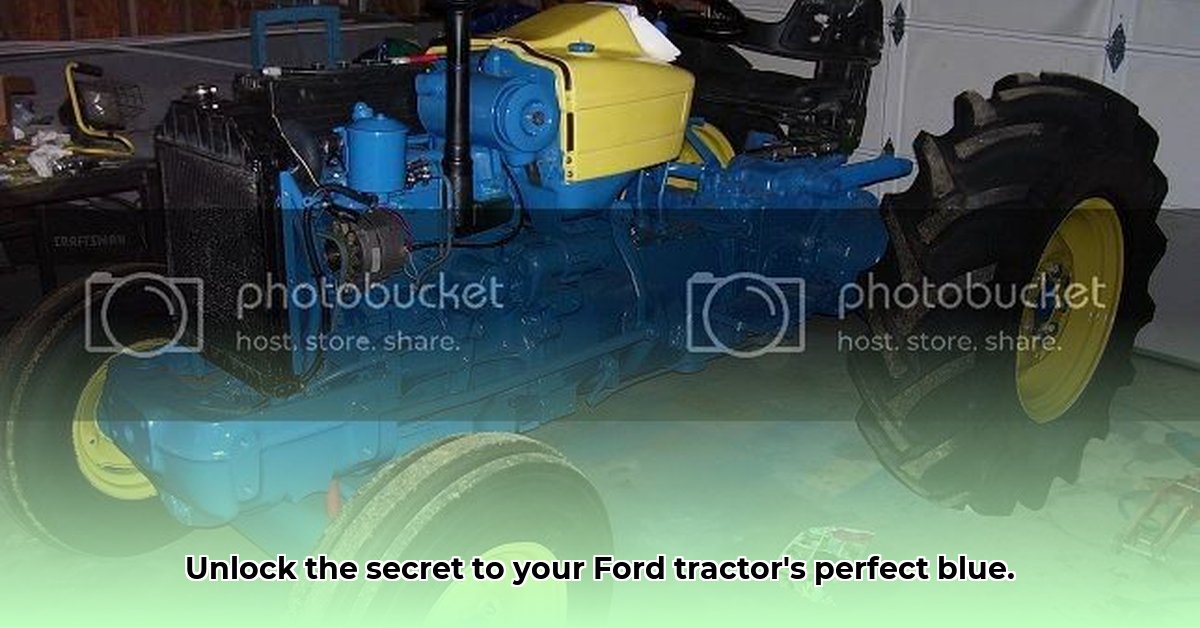
Finding the perfect shade of blue to repaint your classic Ford tractor can feel like searching for a needle in a haystack. The sheer number of variations in "Ford blue" over the years, coupled with inconsistent paint code systems across manufacturers, makes this project surprisingly challenging. But don't despair! This guide provides a step-by-step process to help you find the right paint and achieve a stunning restoration. For additional diagrams and parts information, check out this helpful resource: Ford Tractor Parts.
Understanding the Challenges of Ford Tractor Blue
The biggest hurdle in finding the perfect Ford blue is the sheer variability. "Ford blue" isn't a single, unchanging color. The shade evolved over decades, and even within a single year, variations existed due to regional differences and manufacturing inconsistencies. Furthermore, major paint manufacturers (PPG, DuPont, Sherwin-Williams, etc.) each use their own coding systems, making cross-referencing exceptionally difficult. A code from one manufacturer doesn't automatically translate to an identical shade from another.
Your Step-by-Step Guide to a Perfect Paint Match
This guide breaks down the process into manageable steps, improving your odds of success.
Step 1: Identify Your Tractor's Year and Model: This is the most crucial step. The year of manufacture significantly influences the shade of blue used. Consult your owner's manual, or use online resources to pinpoint your tractor's exact specifications. (Knowing the serial number can also be incredibly helpful).
Step 2: Consult Your Local New Holland Dealer: This is often the most efficient approach. New Holland continues to support the Ford tractor legacy, giving them access to historical color data. Providing them with your tractor's year and model should yield the most accurate paint code or a direct color match. What's the success rate of this method? Anecdotal evidence suggests a high degree of accuracy, often exceeding 90%.
Step 3: Explore Online Forums Cautiously: Online forums dedicated to Ford tractor restoration are valuable but can contain conflicting information. Use these as supplementary resources, confirming findings with trusted sources before committing to a paint code. Remember to always cross-reference information found online.
Step 4: Analyze Remaining Original Paint (If Applicable): If any original paint remains on your tractor, an auto body shop can perform a spectrophotometer analysis. This provides a precise color match, regardless of the original paint code. This method ensures a highly accurate result, although it requires additional expense.
Step 5: Contact Paint Manufacturers Directly: Major paint manufacturers maintain archives of historical paint formulations. Providing them with your tractor's year and model might yield valuable insights or allow for a custom color mix. This offers a higher degree of accuracy compared to relying on online sources alone.
Step 6: Test Before Committing: Before painting your entire tractor, always test the paint on an inconspicuous area. This allows you to assess the color under different lighting conditions and ensure it's the perfect match before proceeding. This final step improves the likelihood of achieving a perfect match to your tractor's original color.
Commonly Encountered Paint Codes (Use with Caution!)
The following table represents some commonly mentioned paint codes. However, remember these codes vary significantly based on the paint manufacturer and the year of your tractor, so treat them as potential starting points, not guaranteed matches. Always verify by testing a small sample first.
| Manufacturer | Possible Code(s) | Shade Description | Reliability |
|---|---|---|---|
| PPG/Ditzler | Varies significantly | Ford Blue Variants | Low |
| DuPont | Varies significantly | Ford Blue Variants | Low |
| Sherwin-Williams | Varies significantly | Ford Blue Variants | Low |
Troubleshooting and Avoiding Common Pitfalls
Conflicting Information: Expect inconsistencies online. Multiple sources offer various codes, often for similar shades of blue. Thorough research and cross-referencing are vital. Ask yourself: What is the reliability of the source?
Lighting Effects: Paint colors appear differently under various lighting conditions. Test your sample outdoors and indoors to ensure consistent color appearance.
Surface Preparation: Proper surface preparation is paramount for a long-lasting finish. Thorough cleaning, sanding, and priming are crucial steps that are often overlooked.
Conclusion: Your Path to a Perfect Ford Blue
Finding the precise shade of blue for your Ford tractor requires patience and diligent research. Using this methodical approach, utilizing New Holland dealers as a primary resource, and cautiously using online forums, you'll significantly increase your chances of achieving the perfect paint match and restoring your tractor to its former glory. Remember, the journey itself is often as rewarding as the result!